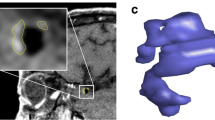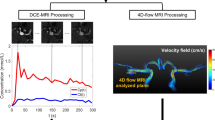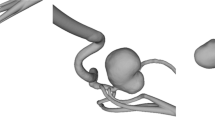Abstract
Objective
Brain aneurysms comprise different compartments that undergo unique biological processes. A detailed multimodal analysis incorporating 3D aneurysm wall enhancement (AWE), computational fluid dynamics (CFD), and finite element analysis (FEA) data can provide insights into the aneurysm wall biology.
Methods
Unruptured aneurysms were prospectively imaged with 7 T high-resolution MRI (HR-MRI). 3D AWE color maps of the entire aneurysm wall were generated and co-registered with contour plots of morphomechanical parameters derived from CFD and FEA. A multimodal analysis of the entire aneurysm was performed using 3D circumferential AWE (3D-CAWE), wall tension (WT), time-averaged wall shear stress (TAWSS), wall shear stress gradient (WSSG), and oscillatory shear index (OSI). A detailed compartmental analysis of each aneurysm’s dome, bleb, and neck was also performed.
Results
Twenty-six aneurysms were analyzed. 3D-CAWE + aneurysms had higher WT (p = 0.03) and higher TAWSS (p = 0.045) than 3D-CAWE- aneurysms. WT, TAWSS, and WSSG were lower in areas of focal AWE in the aneurysm dome compared to the neck (p = 0.009, p = 0.049, and p = 0.040, respectively), whereas OSI was higher in areas of focal AWE compared to the neck (p = 0.020). When compared to areas of no AWE of the aneurysm sac (AWE = 0.92 vs. 0.49, p = 0.001), blebs exhibited lower WT (1.6 vs. 2.45, p = 0.010), lower TAWSS (2.6 vs. 6.34), lower OSI (0.0007 vs. 0.0010), and lower WSSG (2900 vs. 5306). Fusiform aneurysms had a higher 3D-CAWE and WT than saccular aneurysms (p = 0.046 and p = 0.003, respectively).
Conclusions
Areas of focal high AWE in the sac and blebs are associated with low wall tension, low wall shear stress, and low flow conditions (TAWSS and WSSG). Conversely, the neck had average AWE, high wall tension, high wall shear stress, and high flow conditions. The aneurysm dome and the aneurysm neck have different morphomechanical environments, with increased mechanical load at the neck.



Similar content being viewed by others
Data availability
Data is available upon request.
Abbreviations
- HR-MRI:
-
High-resolution MRI
- SI:
-
Signal intensity
- T1 + Gd:
-
T1-weighted post-contrast gadolinium
- AWE:
-
Aneurysm wall enhancement
- 3D-CAWE:
-
Three-dimensional circumferential aneurysm wall enhancement
- WT:
-
Wall tension
- TAWSS:
-
Time-averaged wall shear stress
- WSSG:
-
Wall shear stress gradient
- OSI:
-
Oscillatory shear index
- ROI:
-
Region of interest
References
Cebral JR, Castro MA, Burgess JE, Pergolizzi RS, Sheridan MJ, Putman CM (2005) Characterization of cerebral aneurysms for assessing risk of rupture by using patient-specific computational hemodynamics models. AJNR Am J Neuroradiol 26:2550–2559
Cebral JR, Detmer F, Chung BJ, Choque-Velasquez J, Rezai B, Lehto H, Tulamo R, Hernesniemi J, Niemela M, Yu A, Williamson R, Aziz K, Shakur S, Amin-Hanjani S, Charbel F, Tobe Y, Robertson A, Frosen J (2019) Local hemodynamic conditions associated with focal changes in the intracranial aneurysm wall. AJNR Am J Neuroradiol 40:510–516. https://doi.org/10.3174/ajnr.A5970
Cebral JR, Raschi M (2013) Suggested connections between risk factors of intracranial aneurysms: a review. Ann Biomed Eng 41:1366–1383. https://doi.org/10.1007/s10439-012-0723-0
Fedorov A, Beichel R, Kalpathy-Cramer J, Finet J, Fillion-Robin JC, Pujol S, Bauer C, Jennings D, Fennessy F, Sonka M, Buatti J, Aylward S, Miller JV, Pieper S, Kikinis R (2012) 3D slicer as an image computing platform for the quantitative imaging network. Magn Reson Imaging 30:1323–1341. https://doi.org/10.1016/j.mri.2012.05.001
Ford MD, Alperin N, Lee SH, Holdsworth DW, Steinman DA (2005) Characterization of volumetric flow rate waveforms in the normal internal carotid and vertebral arteries. Physiol Meas 26:477–488. https://doi.org/10.1088/0967-3334/26/4/013
Ford MD, Hoi Y, Piccinelli M, Antiga L, Steinman DA (2009) An objective approach to digital removal of saccular aneurysms: technique and applications. Br J Radiol 82(Spec No 1):S55-61. https://doi.org/10.1259/bjr/67593727
Frosen J (2014) Smooth muscle cells and the formation, degeneration, and rupture of saccular intracranial aneurysm wall–a review of current pathophysiological knowledge. Transl Stroke Res 5:347–356. https://doi.org/10.1007/s12975-014-0340-3
Frosen J, Cebral J, Robertson AM, Aoki T (2019) Flow-induced, inflammation-mediated arterial wall remodeling in the formation and progression of intracranial aneurysms. Neurosurg Focus 47:E21. https://doi.org/10.3171/2019.5.FOCUS19234
Frosen J, Tulamo R, Paetau A, Laaksamo E, Korja M, Laakso A, Niemela M, Hernesniemi J (2012) Saccular intracranial aneurysm: pathology and mechanisms. Acta Neuropathol 123:773–786. https://doi.org/10.1007/s00401-011-0939-3
Galloy AE, Raghuram A, Nino MA, Varon Miller A, Sabotin R, Osorno-Cruz C, Samaniego EA, Raghavan SML, Hasan D (2021) Analysis of cerebral aneurysm wall tension and enhancement using finite element analysis and high-resolution vessel wall imaging. Front Neurol 12:764063. https://doi.org/10.3389/fneur.2021.764063
Geers AJ, Morales HG, Larrabide I, Butakoff C, Bijlenga P, Frangi AF (2017) Wall shear stress at the initiation site of cerebral aneurysms. Biomech Model Mechanobiol 16:97–115. https://doi.org/10.1007/s10237-016-0804-3
Hadad S, Mut F, Chung BJ, Roa JA, Robertson AM, Hasan DM, Samaniego EA, Cebral JR (2020) Regional aneurysm wall enhancement is affected by local hemodynamics: a 7T MRI study. AJNR Am J Neuroradiol. https://doi.org/10.3174/ajnr.A6927
Hashimoto T, Meng H, Young WL (2006) Intracranial aneurysms: links among inflammation, hemodynamics and vascular remodeling. Neurol Res 28:372–380. https://doi.org/10.1179/016164106X14973
Hudson JS, Zanaty M, Nakagawa D, Kung DK, Jabbour P, Samaniego EA, Hasan D (2018) Magnetic resonance vessel wall imaging in human intracranial aneurysms. Stroke. https://doi.org/10.1161/STROKEAHA.118.023701
Khan MO, Toro Arana V, Rubbert C, Cornelius JF, Fischer I, Bostelmann R, Mijderwijk HJ, Turowski B, Steiger HJ, May R, Petridis AK (2020) Association between aneurysm hemodynamics and wall enhancement on 3D vessel wall MRI. J Neurosurg 134(2):565–575. https://doi.org/10.3171/2019.10.JNS191251
Kolega J, Poppenberg KE, Lim HW, Gutierrez LC, Veeturi SS, Siddiqui AH, Rajabzadeh-Oghaz H, Tutino VM (2021) Identification of intima-to-media signals for flow-induced vascular remodeling using correlative gene expression analysis. Sci Rep 11:16142. https://doi.org/10.1038/s41598-021-95403-x
Koseki H, Miyata H, Shimo S, Ohno N, Mifune K, Shimano K, Yamamoto K, Nozaki K, Kasuya H, Narumiya S, Aoki T (2020) Two diverse hemodynamic forces, a mechanical stretch and a high wall shear stress, determine intracranial aneurysm formation. Transl Stroke Res 11:80–92. https://doi.org/10.1007/s12975-019-0690-y
Larsen N, Fluh C, Saalfeld S, Voss S, Hille G, Trick D, Wodarg F, Synowitz M, Jansen O, Berg P (2020) Multimodal validation of focal enhancement in intracranial aneurysms as a surrogate marker for aneurysm instability. Neuroradiology 62:1627–1635. https://doi.org/10.1007/s00234-020-02498-6
Liu P, Song Y, Zhou Y, Liu Y, Qiu T, An Q, Song J, Li P, Shi Y, Li S, Quan K, Yang GY, Zhu W (2018) Cyclic Mechanical stretch induced smooth muscle cell changes in cerebral aneurysm progress by reducing collagen type IV and collagen type VI levels. Cell Physiol Biochem 45:1051–1060. https://doi.org/10.1159/000487347
Liu Q, Zhang Y, Zhu C, Liu W, Ma X, Chen J, Mo S, Dong L, Wang N, Wu J, Liu P, He H, Wang S (2022) Serum IL-1, pyroptosis and intracranial aneurysm wall enhancement: analysis integrating radiology, serum cytokines and histology. Front Cardiovasc Med 9:818789. https://doi.org/10.3389/fcvm.2022.818789
Maas SA, Ellis BJ, Ateshian GA, Weiss JA (2012) FEBio: finite elements for biomechanics. J Biomech Eng 134:011005. https://doi.org/10.1115/1.4005694
Meng H, Tutino VM, Xiang J, Siddiqui A (2014) High WSS or low WSS? Complex interactions of hemodynamics with intracranial aneurysm initiation, growth, and rupture: toward a unifying hypothesis. AJNR Am J Neuroradiol 35:1254–1262. https://doi.org/10.3174/ajnr.A3558
Miller K, Lu J (2013) On the prospect of patient-specific biomechanics without patient-specific properties of tissues. J Mech Behav Biomed Mater 27:154–166. https://doi.org/10.1016/j.jmbbm.2013.01.013
Nordahl ER, Uthamaraj S, Dennis KD, Sejkorova A, Hejcl A, Hron J, Svihlova H, Carlson KD, Suzen YB, Dragomir-Daescu D (2021) Morphological and hemodynamic changes during cerebral aneurysm growth. Brain Sci 11(4):520. https://doi.org/10.3390/brainsci11040520
Patti J, Vinuela F, Chien A (2014) Distinct trends of pulsatility found at the necks of ruptured and unruptured aneurysms. J Neurointerv Surg 6:103–107. https://doi.org/10.1136/neurintsurg-2013-010660
Peng Z, Shu B, Zhang Y, Wang M (2019) Endothelial response to pathophysiological stress. Arterioscler Thromb Vasc Biol 39:e233–e243. https://doi.org/10.1161/ATVBAHA.119.312580
Piccinelli M, Veneziani A, Steinman DA, Remuzzi A, Antiga L (2009) A framework for geometric analysis of vascular structures: application to cerebral aneurysms. IEEE Trans Med Imaging 28:1141–1155. https://doi.org/10.1109/TMI.2009.2021652
Raghuram A, Varon A, Roa JA, Ishii D, Lu Y, Raghavan ML, Wu C, Magnotta VA, Hasan DM, Koscik TR, Samaniego EA (2021) Semiautomated 3D mapping of aneurysmal wall enhancement with 7T-MRI. Sci Rep 11:18344. https://doi.org/10.1038/s41598-021-97727-0
Raghuram A, Varon A, Sanchez S, Ishii D, Wu C, Magnotta VA, Hasan DM, Koscik TR, Samaniego EA (n.d) Topographical analysis of aneurysm wall enhancement with 3-dimensional mapping. Stroke: Vascular and Interventional Neurology 2(4):0:e000309. https://doi.org/10.1161/SVIN.121.000309
Ramachandran M, Laakso A, Harbaugh RE, Raghavan ML (2012) On the role of modeling choices in estimation of cerebral aneurysm wall tension. J Biomech 45:2914–2919. https://doi.org/10.1016/j.jbiomech.2012.07.029
Retarekar R, Ramachandran M, Berkowitz B, Harbaugh RE, Hasan D, Rosenwasser RH, Ogilvy CS, Raghavan ML (2015) Stratification of a population of intracranial aneurysms using blood flow metrics. Comput Methods Biomech Biomed Engin 18:1072–1082. https://doi.org/10.1080/10255842.2013.869322
Russo TA, Stoll D, Nader HB, Dreyfuss JL (2018) Mechanical stretch implications for vascular endothelial cells: altered extracellular matrix synthesis and remodeling in pathological conditions. Life Sci 213:214–225. https://doi.org/10.1016/j.lfs.2018.10.030
Salimi Ashkezari SF, Detmer FJ, Mut F, Chung BJ, Yu AK, Stapleton CJ, See AP, Amin-Hanjani S, Charbel FT, Rezai Jahromi B, Niemela M, Frosen J, Zhou J, Maiti S, Robertson AM, Cebral JR (2021) Blebs in intracranial aneurysms: prevalence and general characteristics. J Neurointerv Surg 13:226–230. https://doi.org/10.1136/neurintsurg-2020-016274
Salimi Ashkezari SF, Mut F, Chung BJ, Yu AK, Stapleton CJ, See AP, Amin-Hanjani S, Charbel FT, Rezai Jahromi B, Niemela M, Frosen J, Maiti S, Robertson AM, Cebral JR (2021) Hemodynamics in aneurysm blebs with different wall characteristics. J Neurointerv Surg 13:642–646. https://doi.org/10.1136/neurintsurg-2020-016601
Seshaiyer P, Hsu FPK, Shah AD, Kyriacou SK, Humphrey JD (2001) Multiaxial mechanical behavior of human saccular aneurysms. Comput Methods Biomech Biomed Engin 4:281–289. https://doi.org/10.1080/10255840108908009
Shimonaga K, Matsushige T, Ishii D, Sakamoto S, Hosogai M, Kawasumi T, Kaneko M, Ono C, Kurisu K (2018) Clinicopathological insights from vessel wall imaging of unruptured intracranial aneurysms. Stroke 49:2516–2519. https://doi.org/10.1161/STROKEAHA.118.021819
Tarbell JM, Weinbaum S, Kamm RD (2005) Cellular fluid mechanics and mechanotransduction. Ann Biomed Eng 33:1719–1723. https://doi.org/10.1007/s10439-005-8775-z
Veeturi SS, Rajabzadeh-Oghaz H, Pinter NK, Waqas M, Hasan DM, Snyder KV, Siddiqui AH, Tutino VM (2021) Aneurysm risk metrics and hemodynamics are associated with greater vessel wall enhancement in intracranial aneurysms. R Soc Open Sci 8:211119. https://doi.org/10.1098/rsos.211119
Wang H, Balzani D, Vedula V, Uhlmann K, Varnik F (2021) On the potential self-amplification of aneurysms due to tissue degradation and blood flow revealed from FSI simulations. Front Physiol 12:785780. https://doi.org/10.3389/fphys.2021.785780
Wang H, Kruger T, Varnik F (2020) Effects of size and elasticity on the relation between flow velocity and wall shear stress in side-wall aneurysms: a lattice Boltzmann-based computer simulation study. PLoS ONE 15:e0227770. https://doi.org/10.1371/journal.pone.0227770
Xiao W, Qi T, He S, Li Z, Ou S, Zhang G, Liu X, Huang Z, Liang F (2018) Low wall shear stress is associated with local aneurysm wall enhancement on high-resolution MR vessel wall imaging. AJNR Am J Neuroradiol 39:2082–2087. https://doi.org/10.3174/ajnr.A5806
Zhong W, Su W, Li T, Tan X, Chen C, Wang Q, Wang D, Su W, Wang Y (2021) Aneurysm wall enhancement in unruptured intracranial aneurysms: a histopathological evaluation. J Am Heart Assoc 10:e018633. https://doi.org/10.1161/JAHA.120.018633
Acknowledgements
The authors would like to acknowledge Heather Widmayer for her work in proofreading the manuscript.
Funding
This work was conducted on an MRI instrument funded by 1S10RR028821-01.
Author information
Authors and Affiliations
Corresponding author
Ethics declarations
Conflict of interest
The authors declare no competing interests.
Additional information
Publisher's note
Springer Nature remains neutral with regard to jurisdictional claims in published maps and institutional affiliations.
This article is part of the Topical Collection on Vascular Neurosurgery—Aneurysm
Supplementary information
Below is the link to the electronic supplementary material.
Rights and permissions
Springer Nature or its licensor (e.g. a society or other partner) holds exclusive rights to this article under a publishing agreement with the author(s) or other rightsholder(s); author self-archiving of the accepted manuscript version of this article is solely governed by the terms of such publishing agreement and applicable law.
About this article
Cite this article
Raghuram, A., Galloy, A., Nino, M. et al. Comprehensive morphomechanical analysis of brain aneurysms. Acta Neurochir 165, 461–470 (2023). https://doi.org/10.1007/s00701-022-05476-4
Received:
Accepted:
Published:
Issue Date:
DOI: https://doi.org/10.1007/s00701-022-05476-4




